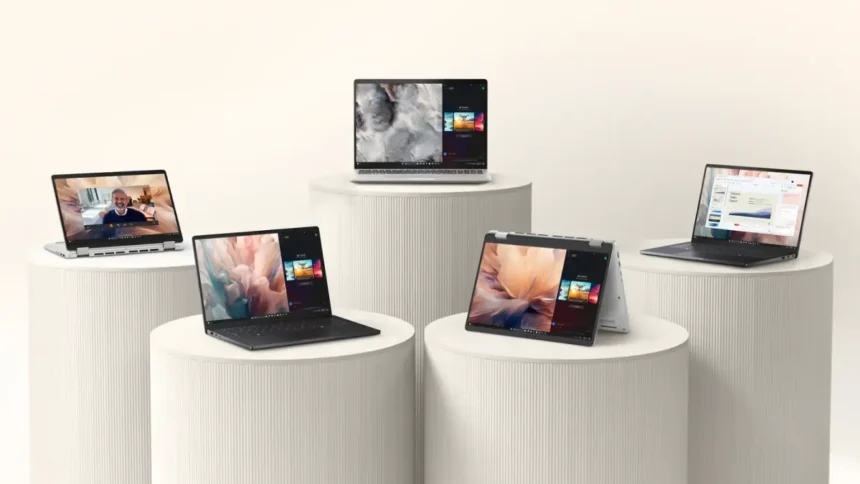Major Changes at Dell: A New Approach to Branding and Product Lines
At CES 2025, Dell unveiled its plan to replace its entire portfolio of computer brands, which include the well-regarded XPS series and others such as Inspiron, Latitude, and Precision. The company’s lineup will be simplified into three primary categories: Dell, Dell Pro, and Dell Pro Max. This initiative, reminiscent of Apple’s strategy, aims to streamline the product offerings, although it may initially lead to some uncertainty among consumers.
In essence, the intention is to focus consumer attention on the Dell brand itself, rather than on various sub-brands. However, several complications arise from this strategy. The terms “Pro” and “Pro Max” have become overly common in the tech industry, often associated with Apple products. Moreover, each tier within Dell’s branding will offer three distinct levels, resulting in a total of nine variants to navigate when purchasing a new computer. This could create a confusing experience, but assistance will be provided for those who find themselves overwhelmed by the new terminology in retail environments.
Dell’s Innovative Nine-Tier Product Framework

The following are some key definitions regarding the new categorizations:
-
Dell: These standard computers cater to the mainstream consumer market, intended for educational use, work, and casual gaming. Available at major retailers, they’re designed for everyday functionality.
-
Dell Pro: Created for business environments, this line is tailored for productivity-focused tasks.
-
Dell Pro Max: Represents the pinnacle of performance, featuring high-end computer builds aimed at demanding applications, including professional workstations.
Fortunately, the Alienware brand, with its high-performance gaming laptops and peripherals, will remain intact during this transition.
The rebranding initiative doesn’t end there. Within each of the three categories, three product tiers are established: Base, Plus, and Premium.

Unsurprisingly, the Base tier across all lines will comprise entry-level systems, each with specifications that reflect their categorization as standard, Pro, or Pro Max. This initial structure makes sense.
However, the distinction becomes less clear with the introduction of the Plus and Premium levels, where the Plus tier acts as a mid-range variant, while Premium is designated for the most advanced machines.
Dell has indicated that the rebranding will unfold gradually, with changes occurring only as new products are launched and older models phased out—potentially extending into late 2025. To distinguish between old and new laptops, look for the difference in logos; previous models featured a circular logo, whereas new systems will simply display “Dell.”
Identifying the New Models Aligned with Former Inspiron and XPS Lines
For those wondering about the successors to the previously affordable Inspiron and Inspiron Plus series, they will now be known as Dell (Base) and Dell Plus, respectively. This results in a rather simplified naming convention, such as a laptop explicitly called “Dell 15.” It may seem unusual, yet these are the options most likely to appeal to those seeking budget-friendly, competent laptops.
As for the former XPS series, the appropriate alternatives would now be within the Premium tiers of Dell Pro and Dell Pro Max. For instance, the freshly launched Dell Pro 13 Premium is designed specifically for business applications, featuring an industry-first Tandem OLED option set to release later in the year.
For business professionals, the Dell Pro Plus range in 13-, 14-, and 16-inch sizes comes equipped with streamlined BIOS systems for easier IT management, alongside USB, HDMI, and Thunderbolt port options. In select configurations, 5G Modems will also be available. The basic Dell Pro series continues to serve budget-conscious business users.
The Dell Pro Max range is intended for high-performance environments and users engaging with advanced applications such as CAD design or AI workloads. Devices in this category will feature Intel’s Ultra Series 2 processors and support for NVIDIA RTX 2000 Ada Generation Laptop GPUs.
For those eager to see what the new models entail, a sponsored video by Linus Tech Tips provides an insightful walkthrough of these changes and highlights key new offerings.
This comprehensive rebranding initiative is accompanied by several notable advancements. Firstly, USB-C ports on all machines will now have a modular design, allowing for easy replacement, contributing significantly to sustainability and device longevity, particularly for business use. Secondly, top-tier Dell Pro Max models will be equipped with full-size SD card slots and dual Thunderbolt 5 ports.
Farewell to the XPS Brand
While navigating this rebranding process may be perplexing, the discontinuation of the XPS series evokes a sense of nostalgia for many technology enthusiasts. The XPS line achieved something remarkable that the Sony VAIO brand could not: it established and maintained a reputation for premium PCs. The XPS line was a pioneer in introducing bezel-less laptop screens, well ahead of competitors.
Nevertheless, every good tale has its conclusion, and according to Dell, these changes are purportedly aimed at enhancing overall quality.
To summarize the essential points:
For standard laptops, opt for Dell or Dell Plus models.
For professional-grade laptops, seek out the Dell Pro and Dell Pro Plus offerings, which replace the previous Latitude series.
XPS-related models will now fall under the Premium category, specifically within Dell Pro Premium and Dell Pro Max Premium. Generally, Dell Pro Max serves as the updated label for high-end products that feature advanced processors and cutting-edge technology.












